
Concept explainers
- (a) (a.1)
Interpretation:
Number of signals expected in each of the following compounds in
Concept introduction:
The number of signals in
For each set of chemically equivalent protons, there will be one signal. For example, the
- (a) (a.1)
Answer to Problem 47P
Compound (1) will show 5 signals in its
Explanation of Solution
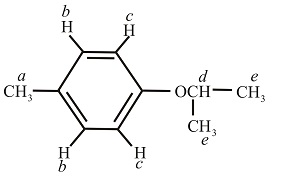
The set of chemically equivalent protons in a compound produces a separate signal in
(a.2)
Interpretation:
Number of signals expected in each of the following compounds in
Concept introduction:
The number of signals in
For each set of chemically equivalent protons, there will be one signal. For example, the
(a.2)
Answer to Problem 47P
Compound (2) will show 5 signals in its
Explanation of Solution
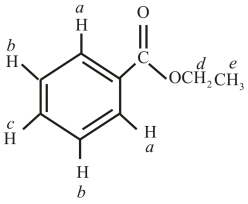
The set of chemically equivalent protons in a compound produces a separate signal in
(a.3)
Interpretation:
Number of signals expected in each of the following compounds in
Concept introduction:
The number of signals in
For each set of chemically equivalent protons, there will be one signal. For example, the
(a.3)
Answer to Problem 47P
Compound (3) will show 4 signals in its
Explanation of Solution

The set of chemically equivalent protons in a compound produces a separate signal in
(a.4)
Interpretation:
Number of signals expected in each of the following compounds in
Concept introduction:
The number of signals in
For each set of chemically equivalent protons, there will be one signal. For example, the
(a.4)
Answer to Problem 47P
Compound (4) will show 2 signals in its
Explanation of Solution

The set of chemically equivalent protons in a compound produces a separate signal in
(a.5)
Interpretation:
Number of signals expected in each of the following compounds in
Concept introduction:
The number of signals in
For each set of chemically equivalent protons, there will be one signal. For example, the
(a.5)
Answer to Problem 47P
Compound (5) will show 3 signals in its
Explanation of Solution
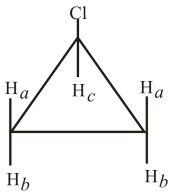
The set of chemically equivalent protons in a compound produces a separate signal in
(a.6)
Interpretation:
Number of signals expected in each of the following compounds in
Concept introduction:
The number of signals in
For each set of chemically equivalent protons, there will be one signal. For example, the
(a.6)
Answer to Problem 47P
Compound (6) will show 3 signals in its
Explanation of Solution
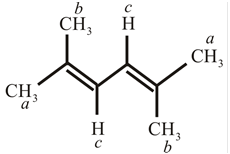
The set of chemically equivalent protons in a compound produces a separate signal in
- (b) (b.1)
Interpretation:
Number of signals expected in each of the following compounds in
Concept introduction:
The signals in the spectrum of a compound are proportional to the number of carbons that are present in the different environment within the molecule. The carbon which is present in the electron-rich environment shows a signal at a lower frequency and vice-versa. Therefore, the carbons that are present nearest to the electron-withdrawing groups produce a high-frequency signal.
- (b) (b.1)
Answer to Problem 47P
Compound (1) will show 7 signals in its
Explanation of Solution

The set of chemically equivalent carbon in a compound produces a separate signal in
(b.2)
Interpretation:
Number of signals expected in each of the following compounds in
Concept introduction:
The signals in the spectrum of a compound are proportional to the number of carbons that are present in the different environment within the molecule. The carbon which is present in the electron-rich environment shows a signal at a lower frequency and vice-versa. Therefore, the carbons that are present nearest to the electron-withdrawing groups produce a high-frequency signal.
(b.2)
Answer to Problem 47P
Compound (2) will show 7 signals in its
Explanation of Solution
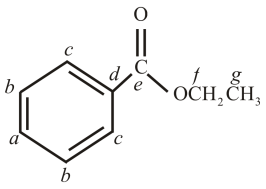
The set of chemically equivalent carbon in a compound produces a separate signal in
(b.3)
Interpretation:
Number of signals expected in each of the following compounds in
Concept introduction:
The signals in the spectrum of a compound are proportional to the number of carbons that are present in the different environment within the molecule. The carbon which is present in the electron-rich environment shows a signal at a lower frequency and vice-versa. Therefore, the carbons that are present nearest to the electron-withdrawing groups produce a high-frequency signal.
(b.3)
Answer to Problem 47P
Compound (3) will show 5 signals in its
Explanation of Solution
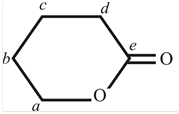
The set of chemically equivalent carbon in a compound produces a separate signal in
(b.4)
Interpretation:
Number of signals expected in each of the following compounds in
Concept introduction:
The signals in the spectrum of a compound are proportional to the number of carbons that are present in the different environment within the molecule. The carbon which is present in the electron-rich environment shows a signal at a lower frequency and vice-versa. Therefore, the carbons that are present nearest to the electron-withdrawing groups produce a high-frequency signal.
(b.4)
Answer to Problem 47P
Compound (4) will show 2 signals in its
Explanation of Solution
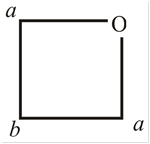
The set of chemically equivalent carbon in a compound produces a separate signal in
(b.5)
Interpretation:
Number of signals expected in each of the following compounds in
Concept introduction:
The signals in the spectrum of a compound are proportional to the number of carbons that are present in the different environment within the molecule. The carbon which is present in the electron-rich environment shows a signal at a lower frequency and vice-versa. Therefore, the carbons that are present nearest to the electron-withdrawing groups produce a high-frequency signal.
(b.5)
Answer to Problem 47P
Compound (5) will show 2 signals in its
Explanation of Solution
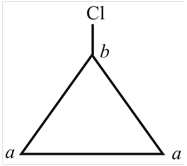
The set of chemically equivalent carbon in a compound produces a separate signal in
(b.6)
Interpretation:
Number of signals expected in each of the following compounds in
Concept introduction:
The signals in the spectrum of a compound are proportional to the number of carbons that are present in the different environment within the molecule. The carbon which is present in the electron-rich environment shows a signal at a lower frequency and vice-versa. Therefore, the carbons that are present nearest to the electron-withdrawing groups produce a high-frequency signal.
(b.6)
Answer to Problem 47P
Compound (6) will show 4 signals in its
Explanation of Solution
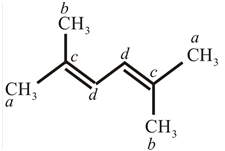
The set of chemically equivalent carbon in a compound produces a separate signal in
Want to see more full solutions like this?
Chapter 14 Solutions
Organic Chemistry (8th Edition)
- For each of the molecules in Problem 16.39, determine how many signals should appear in its 13C NMR spectrum.arrow_forwardWhere would you expect to find the 1H NMR signal of (CH3)2Mg relative to the TMS signal?arrow_forwardAnswer the following questions for compounds L, M, and N drawn below. a.) How many signals are expected in the 1H NMR spectrum?b.) Into how many peaks is each signal in the 1H NMR spectrum split?c.) How many lines are expected in the 13C NMR spectrumarrow_forward
- What would be the multiplicity of the circled hydrogen atom in this compound in the H NMR spectrum?arrow_forwardHow many 13C NMR and 1H NMR peaks is present in the molecule attached?arrow_forwardAnswer the following questions for compounds L, M, and N drawn below.a.How many signals are expected in the 1H NMR spectrum? b.Into how many peaks is each signal in the 1H NMR spectrum split? c.How many lines are expected in the 13C NMR spectrum?arrow_forward
- Which of (a)-(d) indicates the correct order of chemical shifts of the four carbons in the 13C-NMR spectrum of the following compound.arrow_forwardPlease show complete answer. Answer the following questions for compounds L, M, and N drawn below. a.How many signals are expected in the 1H NMR spectrum? b.Into how many peaks is each signal in the 1H NMR spectrum split?arrow_forwardHow many signals will be found in the 13c NMR of 2 propanol at room temperaturearrow_forward
- A compound of formula C5H12 gives 1 signal in the 1H NMR and 2 signals in the 13C NMR. The compound is a. pentane.b. 2-methylbutane.c. 2,2-dimethylpropane.d. Cannot tell without more information.arrow_forwarda) Make a table of the chemical shift, multiplicity and number of hydrogens for each 1H-NMR signal. b) Propose a structure consistent with the data and assign each proton in your structure to a signal in the NMR spectrum.arrow_forwardHow can the signals in the 6.5 to 8.1 ppm region of their 1H NMR spectra distinguish the following compounds?arrow_forward
 Macroscale and Microscale Organic ExperimentsChemistryISBN:9781305577190Author:Kenneth L. Williamson, Katherine M. MastersPublisher:Brooks Cole
Macroscale and Microscale Organic ExperimentsChemistryISBN:9781305577190Author:Kenneth L. Williamson, Katherine M. MastersPublisher:Brooks Cole
